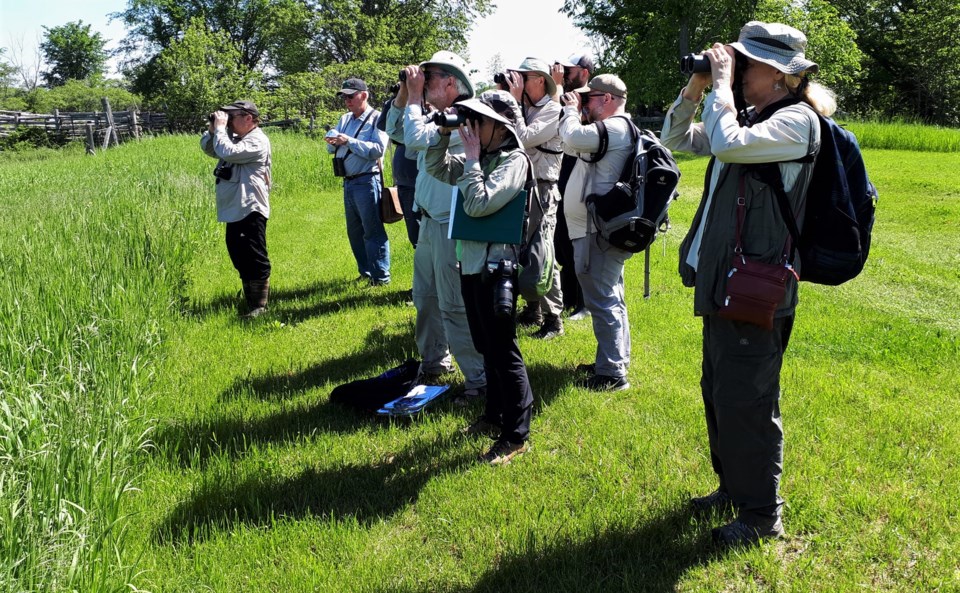Taking the time to observe nature is an eons-old pastime, the big difference between now and then is that we do it for recreation rather than survival. And nowadays we have field guides, and binoculars, and the internet, and apps...
One of the challenges of birdwatching that seems to grow greater the older we age, is being able to see the wee feathered beastie in enough definition to determine whether it's a chipping sparrow or a tree sparrow. It's brown, it has feathers... maybe it's a sparrow? So optical help was invented.
Starting with telescopes, people began switching from guns to glass in order to get close to birds (hey, who would have guessed that pirates were secretly birders?). Somehow, someone, at some time, realized that putting two telescopes up at the same time created life-like 3D imagery, and thus binocular vision was born. (I made that up, in case you were about to use it in your theory of Three-dimensional Viewing of Avian Subjects at Select and Random Distances... just don't go there.)
During the post-war era (as in the 1950s) the new concept of 'vacation time' was being touted and some hard-working but serious birdwatchers began buying optical equipment designed with a birdwatcher in mind. By today's standards these first ones appear to be clunky and underpowered, but in that time a pair of fancy binoculars earned you big points in the birdwatching societies.
Time and technology marched on, and today there are dozens if not hundreds of styles and models of binoculars to choose from. Do you want them to fit in your pocket or be mounted on the dash of your yacht? Tucked in the glove box or survive a life in the bottom of a backpack? Cheep (er, I mean cheap) or dazzlingly expensive? See every barb on every feather or just be happy confirming it's a song sparrow? They are there to be chosen, just do some homework prior to purchasing.
However, no matter the quality, there are a couple of traits that all binoculars share: their power, and the amount of light they let in. Knowing what the funny numbers mean will help you get the right binos for the job.
Take a look at the manufacturing plate atop a pair of binoculars and you will something written like 10x50, 7x35, or 8x40. These are important numbers to understand.
The first number with an x is the power, or amount the image will be enlarged. 10x is ten times more powerful than the human eye; 7x is seven times more powerful, and so on. Know that the bigger the power, the more often heat waves will be exaggerated, and that movement (boat bouncing over waves) will render them almost impossible to use. Birdwatchers generally enjoy 7x or 8x power.
Originally the next number is the diameter, in millimeters, of the front of the lens; recent methods of 'bending light' have resulted in compact-sized binoculars that still function in low light. Basically, the larger the diameter, the more light comes in, and the easier it is to use in low light conditions.
The vast majority of birdwatchers use 7x or 8x equipment. By comparison, a telescope mounted on a tripod for looking at ducks bobbing far out in the bay will have 20x, about equivalent to a red-tailed hawk's everyday vision.
After you have purchased your fabulous new binoculars there comes a moment to set up your new toy for optimum use. Many people don't do the following and become frustrated that they can't clearly see what everybody else is clearly seeing, and will abandon birdwatching for other pursuits. Tragic, but true. So here's what you do:
Step one is to swing the two barrels of your binoculars together and apart. Once loosened up a bit, hold them up to your eyes and look through with both eyes open. Wiggle them together or apart until the "image" you see is a single round viewpoint. Do not believe all those old Western movies where binocular view was portrayed as two overlapping circles. This is real life so get the two barrels positioned to fit your inter-pupillary distance (the distance between your eyes) whether you have beady little eyes or big expressive ones.
For step two, either close your right eye or have a helper hold a piece of cardboard in front of the right barrel. Turn the big focusing ring until something comes into focus. Stay where you are. Now cover the left barrel while you perform a right diopter adjustment. A whaa???
On the right barrel the lens, or diopter, that you peek through actually turns and you will now turn it to balance the binoculars to fit your two wonky eyes. Keep looking at that same thing you first focused on, and with left barrel covered, turn just the diopter until the image come into sharp focus.
Now open both eyes and notice that the big bucks you paid for these binoculars has finally paid off.
Last thing: note the number setting of the right eye diopter, which will be on either side of zero, either a plus or negative mark. This is where you immediately readjust your binos to match your eyes... after lending said binoculars to a friend who has twizzled the right diopter to his/her own preference.
A good field guide, and good set of binoculars and you are off to a good start of a fine day. "Aarrgh, thar be a gull, mateys... be it a Bonaparte or ring-billed? Bring her about while we haves ourselves a better viewing!"
